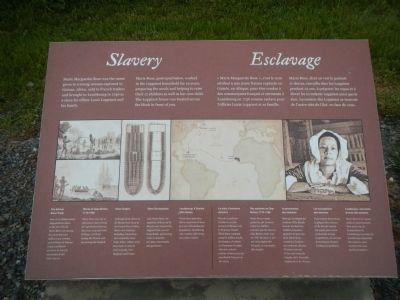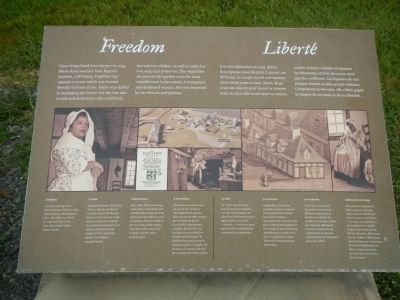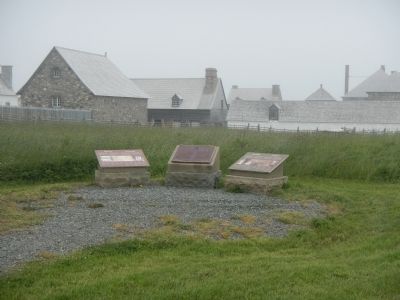Near Louisbourg in Cape Breton Region, Nova Scotia — The Atlantic Provinces (North America)
Slavery / Freedom
Esclavage / Liberté

Photographed By Barry Swackhamer, July 3, 2014
1. Slavery / Esclavage Marker
Captions (English / French): (left to right) The African Slave Trade One of 12 million slaves shipped from Africa to the New World, Marie Rose was among the more than one million men, women, and children of African origin purchased as slaves by French merchants in the 18th century. / La traite d’esclaves africains Plus de 12 millions d’esclaves ont été envoyés d’Afrique vers le Nouveau Monde. Marie Rose comptait parmi le million et plus de femmes, d’enfants et d’hommes d’origine africaine achetés comme esclaves par des marchands français au 18 siècle.; Slaves in Cape Breton, 1713-1768 Marie Rose was one of 381 known slaves living in Cape Breton between the years 1713 ad 1768. Of these, 277 lived among the French and 104 among the English. / Des esclaves au Cap-Breton, 1713-1768 Marie Rose compte parmi les 381 esclaves (selon les chiffres connus) qui ont vécu au Cap-Breton entre 1713 et 1768. De ceux-ci, 277 ont vécu auprès Français, et 104 auprès des Anglais.; Slave Origins Although most slaves in Île Royale were born in the French West Indies, there were fourteen, including Marie Rose, who originally came from Africa. Others were born here or arrived from Canada, New England and France. / Le provenance des esclaves Bien que la plupart des esclaves à l’Île Royale fussent nés dans les Antilles françaises, quatorze d’entre eux, dont Marie Rose, venaient à l’origine du continent africain. C’autres son nés ici ou sont venus du Canada, de la Nouvelle Angleterre et de Franc.; Slave Occupations Like Marie Rose, the majority of slaves in Île Royale were acquired to support their owner’s households, performing work as domestic servants, nursemaids, and gardeners. / Les occupations des esclaves Tout comme Marie Rose, la plupart des esclaves à l’Île Royale avaient été acquis pour servir au domicile de leur propriétaire, en tant que domestiques, bonnes d’enfant ou jardiniers.; Louisbourg: A Society With Slaves Marie Rose and other slaves represented three per cent of Louisbourg’s population. Louisbourg was a society with slaves, not a slave society. / Louisbourg: une société des esclaves Marie Rose et les autres esclaves représentaient trois pour cent de la population de Louisbourg; la société de Louisbourg comportait des esclaves, sans toutefois être une société d’esclaves.
English:
Marie Marguerite Rose was the name given to a young woman captured in Guinea, Africa, sold to French traders and brought to Louisbourg in 1736 as a slave for officier Louis Loppinot and his family.
Marie Rose, portrayed below, worked in the Loppinot household for 19 years, preparing the meals and helping to raise their 12 children as well as her own child. The Loppinot house was located across the block in front of you.
French:
«Marie Marguerite Rose», c’est le nom attribué à une jeune femme capturée en Guinée, en Afrique, pour être vendue à des commerçants français et emmenée à Louisbourg en 1736 come esclave pour l’officier Louis Loppinot et sa famille.
Marie Rose, dont on voit le portrait ci-dessus, travailla chez les Loppinot pendant 19 ans, à préparer les repas et à élever les 12 enfants Loppinot ainsi que le sien. La maison des Loppinot se trouvait de l’autre côté de l’îlot en face de vous.
English:
Upon being freed from slavery in 1755, Marie Rose married Jean Baptiste Laurent, a Mi’kmaq. Together they opened a tavern which was located directly in front of you. Marie was skilled in managing the tavern but she was also a cook and seamstress who could knit, dye and iron clothes, as well as make her own soap and preserves. The vegetables she grew in her garden were the most valuable item in her estate. A competent and dedicated woman, she was respected by her friends and patrons.
French:
Une fois affranchie en 1755, Marie Rose épousa Jean-Baptiste Laurent, un Mi’kmaq. Le couple ouvrit in taverne, alors située en face. Marie Rose avait des talents pour mener la taverne mais en plus, elle savait faire la cuisine, coudre, tricoter, teindre, et repasser les vêtements, et faire du savon ainsi que des confitures. Les légumes de son potager étaient sa plus grande richesse. Compétente et dévouée, elle s’était gagné le respect ses amis et de sa clientèle.
Erected by Parks Canada.
Topics and series. This historical marker is listed in this topic list: African Americans. In addition, it is included in the Acadian History series list. A significant historical year for this entry is 1736.
Location. 45° 53.517′ N, 59° 59.059′ W. Marker is near Louisbourg, Nova Scotia, in Cape Breton Region. Touch for map. Marker is in this post office area: Louisbourg NS B1C 2L2, Canada. Touch for directions.
Other nearby markers. At least 8 other markers are within 3 kilometers of this marker, measured as the crow flies. Marie Marguerite Rose (here, next to this marker); Fizel House (within shouting distance

Photographed By Barry Swackhamer, July 3, 2014
2. Freedom / Liberté Marker
Captions (English / French): (left to right) A Mother In 1738, a the age of 21, Marie Rose gave birth to a son, Jean François, who became a slave. The father was listed as “unknown” but slaves were often sexual victimes of their owners. / La mère En 1738, à l’âge de 21 ans, Marie Rose donna naissance à un fils, Jean-François, qui allait à son tour devenir esclave. Quant au père, il est resté «inconnu» : il arrivait souvent que des esclaves subissent les avances de leur propriétaire.; A Cook Although illiterate, Marie Rose has a cookbook entitled Le Cuisinier Royal. She did not learn to read and write so she may have kept the cookbook as a prized possession because other people had read the recipes for her. Numerous slave is Louisbourg prepared meals. / La cuisinière Analphabète, Marie Rose possédait pourtant un livre de cuisine intitulé Le Cuisinier Royal. Elle n’avait pu apprendre à lire et à écrire; il se peut qu’elle ait tenu à garder ce livre puisque d’autres personnes déchiffraient les recettes pour elle. À Louisbourg, les repas étaient souvent préparés par des esclaves.; A Seamstress Marie Rose knitted stockings, made shirts, dyed clothes and collected fabric remnants from which she made different types of clothing, along with balls of her own home-made soap to wash the clothes and an iron to ensure that they were neatly pressed. / La couturière Marie Rose tricotait des chaussettes, recousait des chemises, préparait de la teinture et recueillait des retailles de tissu pour en faire des vêtements. Elle faisait la lessive avec du savon de sa fabrication et repassait soigneusement les vêtements qu’on lue confiait.; A Freed Slave Marie Rose was freed at the age of 38, one of only six slaves emancipated in Île Royale. Since she was an older woman, her owners freed her for fear that she might become a liability. She died in 1757, less than two years after her freedom and marriage. The details of her estate inventory of assets, unique in Canada, tell the story of a woman who had been recently freed from slavery. / Libérée de l’esclavage Marie Rose fut affranchie à l’âge de 38 ans; seuls cinq autres esclaves à l’Île Royale ont pu recouvrer leur liberté. Vu son âge, ses propriétaires ne tenaient pas à ce qu’elle tombe à leur charge et ainsi, ils l’ont affranchie. Elle mourut en 1757, mariée et libre depuis moins de deux ans. L’inventaire de ses biens établi après son décès, unique au Canada, nous fait parcourir un peu de son histoire.
More about this marker. This marker is located on the grounds of Fortress Louisbourg near the McLennan House.
Also see . . . Slavery in Canada? I never learned that - Active History. African slavery existed in the colonies of New France and British North America for over 200 years, yet there remains a profound silence in classrooms and teaching resources about Canada’s involvement in the African slave trade. According to available historical documents, least 4,000 Africans were held in bondage for two centuries in the early colonial settlements of New France (Quebec), New Brunswick, Prince Edward Island, Nova Scotia, and Upper Canada (Ontario). (Submitted on December 27, 2014, by Barry Swackhamer of Brentwood, California.)
Credits. This page was last revised on July 23, 2018. It was originally submitted on December 27, 2014, by Barry Swackhamer of Brentwood, California. This page has been viewed 420 times since then and 15 times this year. Photos: 1, 2, 3. submitted on December 27, 2014, by Barry Swackhamer of Brentwood, California. • Andrew Ruppenstein was the editor who published this page.
